NSW TrainLink
 | |
|
V set at Sydney Central in July 2013 | |
| Overview | |
|---|---|
| Owner | Transport for New South Wales |
| Locale | New South Wales (outside Sydney) |
| Transit type | Intercity and regional rail and coach |
| Annual ridership | 36.3 million (2014/15) |
| Website | www.nswtrainlink.info |
| Operation | |
| Began operation | 1 July 2013 |
| Operator(s) | NSW Trains and private coach operators |
NSW TrainLink is an Australian brand for the medium and long distance passenger rail and coach services of the New South Wales Government's transport authority, Transport for NSW.[1] NSW TrainLink services operate throughout New South Wales and extend into the neighbouring states and territories of Victoria, Queensland and the Australian Capital Territory. Train services are operated by the government's NSW Trains. Coach services are contracted to private operators.
History
In May 2012, the Minister for Transport announced a restructure of RailCorp. Operation of Sydney suburban train services was split from medium and long distance train services. Two new companies - Sydney Trains and NSW Trains - were created to operate the passenger rail network.[2][3][4][5]
The NSW TrainLink brand was introduced on 1 July 2013 to coincide with NSW Trains taking over all of CountryLink's services and CityRail's non-suburban services.
NSW Trains also took responsibility from RailCorp for granting access to and maintaining the Main Northern line from Berowra to Newcastle, the Main Western line from Emu Plains to Bowenfels and the Illawarra line from Waterfall to Bomaderry.
Network
The NSW TrainLink network is divided into two tiers, branded as Intercity and Regional. Intercity services operate commuter style services, mainly to and from Sydney with limited stops within the metropolitan area. The Intercity network is part of Transport for NSW's Opal ticketing system. Seats on Intercity services are available on a first-come, first-served basis. Regional services operate in areas of lower population density, providing passenger transport mainly between regional NSW and Sydney (although some cross country and interstate services operate). Regional services use a separate, reserved seat, ticketing system.
Intercity services

Intercity services operate to a distance approximately 200 kilometres from Sydney, bounded by Dungog in the north. Scone in the north-west, Bathurst to the west, Goulburn in the south-west and Bomaderry to the south.
Electric services extend from Sydney north to Hamilton (Newcastle), west to Lithgow and south to Port Kembla and Kiama. Most electric services originate from or terminate at Central.
Diesel trains serve the more distant or less populated parts of the Intercity network. Hunter Line services operate from Hamilton to Telarah with some extending to Dungog and Scone. Southern Highlands Line services operate between Campbelltown and Moss Vale with a limited number extending to Sydney and Goulburn. Diesel services also operate on the South Coast Line between Kiama and Bomaderry. The Bathurst Bullet provides a daily, limited stop service between Sydney and Bathurst.
Train services
| Line colour and name | Between | Electric services |
|---|---|---|
| Centrala and Lithgow with limited services to Bathurst | To Lithgow | |
| Central and Hamilton (Newcastle) | Yes | |
| Centralb and Bomaderry or Port Kembla | To Kiama and Port Kembla | |
| Campbelltownc and Moss Vale with limited services to Goulburn | No | |
| Hamilton (Newcastle) and Telarah with limited services to Dungog or Scone | No |
- ^a Some peak services on the Blue Mountains Line run to/from Hornsby
- ^b Some peak services and most weekend services on the South Coast Line run to/from Bondi Junction
- ^c Some peak services on the Southern Highlands Line run to/from Central. At other times, a change of train is required at Campbelltown
Intercity train fares
The Opal fare system for Intercity services is fully integrated with the Sydney Trains network - trips involving both Intercity and Sydney suburban services are calculated as a single fare and there is no interchange penalty. Opal is also valid on bus, ferry and light rail services in the Greater Sydney region (except for the Southern Highlands) but separate fares apply for these modes. The following table lists Opal fares for reusable smartcards and single trip tickets:
| Train | 0–10 km | 10–20 km | 20–35 km | 35–65 km | 65 km+ |
|---|---|---|---|---|---|
| Adult cards (peak) | $3.38 | $4.20 | $4.82 | $6.46 | $8.30 |
| Adult cards (off-peak) | $2.36 | $2.94 | $3.37 | $4.52 | $5.81 |
| Other cards (peak) | $1.69 | $2.10 | $2.41 | $3.23^ | $4.15^ |
| Other cards (off-peak) | $1.18 | $1.47 | $1.68 | $2.26 | $2.90^ |
| Adult single trip | $4.10 | $5.10 | $5.80 | $7.80 | $10.00 |
| Child/Youth single trip | $2.00 | $2.50 | $2.90 | $3.90 | $5.00 |
^ = $2.50 for Pensioner/Senior cardholders
Card fares as of 4 January 2015. Single trip fares as of 5 September 2016.[6][7]
Bus and coach services
NSW TrainLink operates several bus routes along corridors where the railway line has been closed to passengers or as a supplement to rail services. These bus services are operated by private sector bus companies contracted by NSW TrainLink.
- Wollongong to Moss Vale/Bundanoon(r)
- Moss Vale to Goulburn
- Picton to Bowral via Picton-Mittagong loop line on weekdays only
- ^(r) Seat reservations required
Regional services
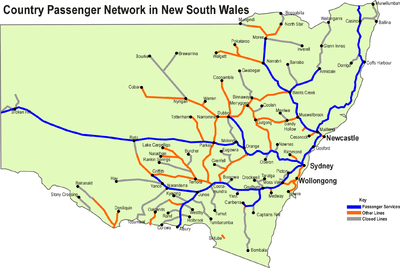
NSW TrainLink operates passenger services throughout New South Wales and interstate to Brisbane, Canberra and Melbourne. All rail services feature diesel rolling stock.
North Coast
The North Coast services operate through the Mid North Coast, Northern Rivers and South East Queensland regions. The Government of Queensland makes a financial contribution to the provision of these services. Services operate on the Main North and North Coast lines from Sydney Central station to Roma Street station in Brisbane.[8]
Principal stations served by XPT trains are:
Cities and towns served by NSW TrainLink coaches connecting off North Coast services include: Tea Gardens, Forster, Port Macquarie, Yamba, Moree, Alstonville, Lismore, Ballina, Byron Bay, Murwillumbah, Tweed Heads and Surfers Paradise.
North Western
The North Western region services operate through the Hunter, New England and North West Slopes & Plains regions. Services operate on the Main North line from Sydney Central station to Werris Creek. where the service divides for Armidale and Moree.[9]
Principal stations served by Xplorer trains are:
Cities and towns served by NSW TrainLink coaches connecting off North Western services include: Wee Waa, Inverell, Grafton, Glen Innes and Tenterfield.
Western

The Western region services operate through the Central Tablelands, Orana, and Far West regions. Services operate on the Main Western line from Sydney Central station to Dubbo and the Broken Hill line to Broken Hill.[10]
Principal stations served by XPT trains are:
Principal stations served by Xplorer trains are:
Cities and towns served by NSW TrainLink coaches connecting off Western services include: Oberon, Mudgee, Baradine, Cowra, Grenfell, Forbes, Parkes, Condobolin, Lightning Ridge Brewarrina, Bourke, Warren and Broken Hill.
Southern
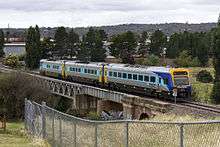
The Southern region services operate through the Illawarra, South Coast, Monaro, South West Slopes, Southern Tablelands, Riverina, and Sunraysia regions, plus the Australian Capital Territory and parts of Victoria. The Government of Victoria contributes financially to the provision of the interstate services. The ACT Government does not make a financial contribution.
Services operate on the:
- Main South line from Sydney Central station to Albury then continue on the North East line to Southern Cross station in Melbourne
- Bombala line from south of Goulburn to Queanbeyan where services join the Canberra line to terminate inside the Australian Capital Territory at Canberra
- Hay line from Junee to Yanco where services join the Yanco-Griffith line to Griffith[11]
Principal stations served by XPT trains are:
Principal stations served by Xplorer trains are:
Cities and towns served by NSW TrainLink coaches connecting off Southern services include: Wollongong, Bombala, Eden, Tumbarumba, Bathurst, Dubbo, Condobolin, Griffith, Mildura and Echuca.
Coach services
%2C_in_NSW_TrainLink_livery%2C_Irizar_i6_bodied_Scania_K310IB_at_Wagga_Wagga_Railway_Station.jpg)
%2C_in_NSW_TrainLink_livery%2C_Fuso_Rosa_at_Wagga_Wagga_Railway_Station.jpg)
NSW TrainLink continued with the existing contracts entered into by CityRail and CountryLink for the provision of coach services.
On 1 July 2014, the Lithgow to Gulgong, Coonabarabran, Baradine services passed from Greyhound Australia to Ogden's Coaches.[12]
In July 2014, Transport for NSW commenced the re-tendering process for most of the routes with the previous 24 contracts reorganised into 18 contracts. The new contracts commenced on 1 January 2015 for a five-year period, with an option to extend for three years if performance criteria is met.[12][13] The services operated by Sunstate Coaches and Wolters Bus & Coach Service commenced new five-year contracts on 1 July 2016.[14][15]
The full list of coach operators providing services as at January 2015 was:[12][16]
+ not included in January 2015 re-tendering process
Fleet
The NSW TrainLink fleet consists of both diesel and electric traction, with the oldest of the fleet being the V sets and the youngest being the H sets, the latter are shared with Sydney Trains. Tangaras operate some peak hour South Coast Line services as far as Wollongong. The entire NSW Trainlink fleet is maintained by Sydney Trains either directly or via a Sydney Trains contract with UGL Rail.
| Class | Image | Type | Top speed | Carriage Numbers | Routes operated | Built | |
|---|---|---|---|---|---|---|---|
| km/h | mph | ||||||
| Endeavour Railcar | |
Diesel Multiple Unit | 145 | 90 | 28 | Hunter South Coast (Kiama to Bomaderry) Blue Mountains (Bathurst Bullet) Southern Highlands |
1994-96 |
| H Set Oscar |  |
Electric Multiple Unit | 130 | 81 | 221 (Shared with Sydney Trains) | Central Coast & Newcastle South Coast Blue Mountains (as far as Springwood) |
2006-12 |
| Hunter Railcar | 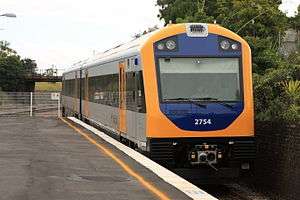 |
Diesel Multiple Unit | 145 | 90 | 14 | Hunter | 2006 |
| T Set Tangara | 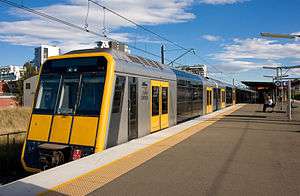 |
Electric Multiple Unit | 115 | 72 | 447 (Shared with Sydney Trains) | South Coast (Waterfall to Port Kembla) | 1987-95 |
| V Set | |
Electric Multiple Unit | 115 | 72 | 196 | Central Coast & Newcastle Blue Mountains |
1977-89 |
| Xplorer |  |
Diesel Multiple Unit | 145 | 90 | 23 | North Western Southern (to Canberra and Griffith) Western (to Broken Hill) |
1993 |
| XPT | 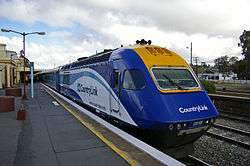 |
Diesel locomotive & Passenger carriage |
160 | 99 | 19 Power cars 60 passenger carriages |
North Coast Southern (to Melbourne) Western (to Dubbo) |
1981-94 |
Future rolling stock
A fleet of 512 new carriages will be introduced to the NSW TrainLink intercity network. The first train is scheduled for delivery in 2019.[17] These electric trains will replace the V sets and allow at least some H sets to be transferred to Sydney Trains services.[18][19]
In 2015, the NSW Government allocated $7.5 million to start planning for a new fleet of diesel trains to replace the XPTs.[20] The procurement process will begin in the first half of 2017. The government is also considering replacing the Xplorer and Endeavour trains.[21]
Performance
In the year ended 30 June 2016, 38.5 million journeys were made on intercity services. There were 1.8 million journeys on regional services. Patronage on intercity services increased by 11.3 per cent over the previous financial year but fell by 0.2 per cent for regional services, continuing a trend of decreasing patronage since 2011-12 when it peaked at 2.0 million passenger journeys. Regional train patronage increased, but coach patronage fell by almost 5 per cent.[22]
Intercity services are considered on-time if they operate within six minutes of their scheduled time.[23] For regional services the benchmark is ten minutes.[24] The target is for 92 per cent of intercity services and 78 per cent of regional services to operate on-time. In 2015-16 NSW Trains failed to meet the Intercity target during peak hours (the peak hour figure is the only one available). However, regional services achieved their punctuality target for the first time in 13 years.[22]
The following table lists patronage figures for the network (in millions of journeys) during the corresponding financial year. Australia's financial years start on 1 July and end on 30 June. Major events that affected the number of journeys made or how patronage is measured are included as notes.
| 2013-14[25] | 2014-15[25] | 2015-16[26] | |
|---|---|---|---|
| Intercity | 32.9[note 1] | 34.5[note 2] | 38.5[note 3] |
| Regional | 1.81 | 1.76 | 1.76 |
Quiet carriages
Quiet carriages are designated carriages where noise made by passengers are requested to be kept to a minimum. Passengers are asked to place mobile phones on silent, move carriages in order to have a conversation with another passenger and use headphones when listening to music.[27]
Quiet carriages are on Intercity services are located in four carriages on 8 car sets, two carriages on 4 car sets and one carriage on two car sets.[28]
Quiet carriages were first introduced on the Central Coast & Newcastle Line in early 2012 as a three-month trial. On 1 September 2012 quiet carriages were permanently introduced and expanded to all intercity services operating on the Blue Mountains and South Coast lines.[27] As of 2013, Quiet Carriages operate on the entire NSW TrainLink Intercity network.
Depots
The XPT fleet is maintained at the XPT Service Centre and the Endeavour and Xplorer fleets at Eveleigh Railway Workshops. The V sets are maintained at Flemington Maintenance Depot. The new Intercity trains will be maintained at a new facility at Kangy Angy.
References
- ↑ Annual Report 30 June 2012 RailCorp
- ↑ "RailCorp job cuts first of many: unions" Sydney Morning Herald 15 May 2012
- ↑ "Ruthless RailCorp reforms planned as middle management axed" Daily Telegraph 15 May 2012
- ↑ Corporate Plan 2012/13 RailCorp
- ↑ "700 jobs to go as RailCorp gets the axe" Daily Telegraph 16 November 2012
- ↑ "New fares from 4 January 2015". transportnsw.info. Transport for NSW. 5 December 2014. Archived from the original on 25 December 2014.
- ↑ "Fares and benefits". opal.com.au. Transport for NSW. Retrieved 13 September 2016.
- ↑ "North Coast timetable" (PDF). NSW Trainlink. 20 October 2013 [Updated 6 April 2014].
- ↑ "North West timetable" (PDF). NSW Trainlink. 20 October 2013.
- ↑ "Western timetable" (PDF). NSW Trainlink. 20 October 2013 [Updated 15 June 2013].
- ↑ "Southern timetable" (PDF). NSW Trainlink. 20 October 2013 [Updated 30 June 2014].
- 1 2 3 "New NSW TrainLink Rural Coach Service Contracts". Australian Bus (68): 20. March 2015.
- ↑ Provision of NSW Rural Coach Services NSW eTendering 11 July 2014
- ↑ Contract Award Notice Detail NSW eTendering 19 July 2016
- ↑ Contract Award Notice Detail NSW eTendering 19 July 2016
- ↑ NSW TrainLink coach service suppliers NSW TrainLink
- ↑ "Comfort comes first with New Intercity Trains". Transport for NSW. 18 August 2016.
- ↑ NSW Government to invest $2.8 billion in new intercity trains, making all trains air-conditioned Transport for New South Wales 8 May 2014
- ↑ Intercity Fleet Program Transport for New South Wales
- ↑ "Budget delivers $9 billion for public transport services and infrastructure". Transport for NSW. 23 June 2015. Retrieved 23 June 2015.
- ↑ "New country train program accelerated". Transport for NSW. 28 October 2016.
- 1 2 "NSW Trains 2015-16 Annual Report Volume 1" (PDF). NSW Trains. pp. 17, 22–23. Retrieved 18 November 2016.
- ↑ "Our performance". Sydney Trains. Retrieved 2 December 2015.
- ↑ "Punctuality 2015". NSW Trains. Retrieved 21 October 2016.
- 1 2 "Transport for NSW Annual Report 2014-15" (PDF). Transport for NSW. p. 131. Retrieved 1 August 2016.
- ↑ "NSW Trains 2015-16 Annual Report Volume 1" (PDF). NSW Trains. p. 17. Retrieved 18 November 2016.
- 1 2 Quiet carriages now permanent on Blue Mountains and South Coast intercity services Sydney Trains
- ↑ Quiet carriages to expand on South Coast line Illawarra Mercury 3 July 2013
External links
| Wikimedia Commons has media related to NSW TrainLink. |